Porcelain Insulator News
by Elton Gish
Reprinted from "Crown Jewels of the Wire", May 1995, page 8
In the November 1993 issue of Crown Jewels of the Wire, we showed pictures of
a couple of very early suspension insulators that were made up of two pieces
cemented together. One was made by Thomas and the other by Locke. Each style was
cataloged in the 1910’s. The Locke suspension was marked with the VICTOR R=oo
inside the insulator logo. Now a couple of earlier styles have been reported!!
Bill Rohde (NIA #1219) sent in some nice photographs of his 14-inch diameter,
2-part cemented suspension insulator. The cemented in petticoat is 6-1/2 inches
in diameter and the glaze color is the typical speckled rust-brown found on
early Victor marked insulators. This insulator was evidently made before the
insulator logo marking was used. The marking is quite clear: VICTOR / PAT’D
FEB. 25 ’08. As an example of perfect timing, I just received a letter from
Mark Lauckner (NIA #4730) which included several photographs of nearly the same
insulator with identical marking! The only difference is that Mark’s insulator
has a longer split connector pin cemented in the bottom. Mark said his insulator
was found in the vicinity of the Goldstream power plant in Victoria, BC. This is
the location of the first British Columbia Electric Co. generating station. Look
for Mark’s future article on the power plant in the Canadian Insulator
Magazine.
The patent date in the marking is John Duncan’s patent No. 880,203. Look
back on page 22 of the November 1991 issue of Crown Jewels of the Wire and you
will see two old photographs which show how this type of insulator was
assembled. The split connector ring, with eye formed on the end, fit into the
cast iron cap of the unit below and was held in place by a bolt. These very
heavy insulators probably weigh about 20-25 pounds each. In addition to problems
with cement expansion which caused the porcelain to break, the 2-part
construction produced an insulator that was not well balanced electrically.
Also, the cap and pins suffered under the strain of the suspended cable and
frequently pulled apart. The Duncan design was a failure and the cap and pin
design was not perfected until a number of years later after the use of the
Hewlett became widespread. It is amazing that any specimens of the early Duncan
design have survived. Needless to say they are quite rare. In fact, any 2-part
suspension is very rare indeed.
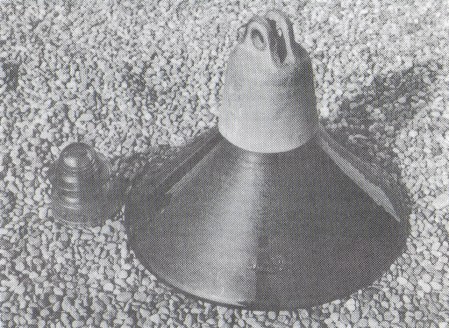
Victor 14-inch, two-part porcelain suspension insulator
marked with the Duncan patent date.
For size comparison, there is a CD 164 signal to the left.

Marking showing the
John Duncan’s patent date.
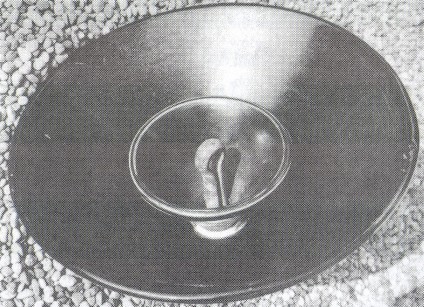
Bill Rohde’s insulator (above) and Mark Lauckner’s
insulator (below). Note the longer split connector pin.
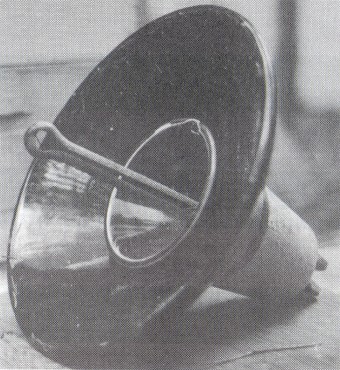
The Pittsburg High-Voltage Insulator Co. was in operation from 1908 until
about 1921. They turned out many hundreds of millions of insulators in more
styles than any other company. Apparently insulator quality was not very
important. The quality of their insulators was often quite low and notable for
crudeness and non-uniform glazes on the smaller unipart styles. They evidently
undercut prices of other insulator companies preferring to satisfy all customer’s
needs no matter how small the order. Demand for electricity and telephone
service produced a great need for insulators and Pittsburg was there to meet
that need. An example of Pittsburg’s excesses at providing insulators to meet
any customer’s demand can be found in their catalog No. 20 (circa 1920) where
they offered 26 unipart styles and 28 multipart styles. How could they possibly
produce so many different styles and maintain any sort of efficiency? Evidently
their overextended product variety and quality control contributed to their
downfall. Pittsburg also continued producing multipart styles with flared skirts
long after other companies had realized these designs had problems with cement
expansion and electrical imbalances.
Brent Mills’ book, Porcelain Insulators and How They Grew, mentioned that
one company cataloged a 5-part porcelain insulator. That was such a foolish idea
that I always thought it could not have been true. The suspension insulator had
easily met the industry need for a satisfactory inexpensive insulator on high
voltage transmission lines. I recently obtained a copy of Pittsburg’s No. 20
catalog and to my surprise the 5-part insulator dinosaur was offered! If it was
actually produced, the cement expansion and electrical imbalances must have
forced an early death for this design. There are size and cost limits for
multipart porcelain insulators whereby weight, cement expansion, and electrical
design make suspension insulators economically attractive, and the M-5000 design
definitely exceeded all limits. This 20-inch diameter insulator (M-5000) was
cataloged for 120,000 volts and weighed 100 pounds!
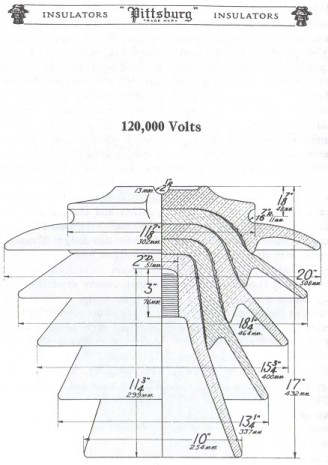
Large Image (142 Kb)
Jeff Kaminski (NIA #3582) reported a new style of multipart insulator that
is almost as big as Pittsburg’s M-5000. This 18-inch diameter 4-part insulator
is M-4820. The marking is a small insulator logo with VICTOR R=oo inside. This
is perhaps the largest pin-type insulator known and weighs 80 pounds. The record
for the heaviest insulator goes to Pinco’s M-4750 which weighs 92 pounds.

M-4820 with marking: Victor R=oo in small insulator logo
18 - 11 - 13 - 9.5 x 16
Fred Collier, Jr. (NIA #2933) reported several new unipart styles which we
will get to next month; however, one of his insulators is so notable that I
would like to tell you about it now. His insulator is similar to U-4 with the
major difference being that it is slightly thinner looking. Fred first reported
this insulator on the survey I sent him as having a light blue glaze with dark
blue specs. Indeed, this is exactly what the glaze looks like. So, what makes
this insulator so unusual? Only one other insulator has been reported with this
glaze. Before Ken Willick’s report in the March 1995 issue of Crown Jewels of
the Wire of a white U-376, only one specimen of U-376 was known and it has a
light blue glaze with dark blue specs! This unique glaze is easily attributed to
its manufacturer because the blue U-376 is clearly marked, LIMA, N.Y. Fred sent
his Sim U-4 to me for a closer examination. Sure enough, it has the typical
characteristics of a Lima made insulator: the pinhole is glazed and there is a
near dime-sized impression in the top of the pinhole. I would be interested to
hear from anyone who has an insulator with this same light blue glaze with dark
blue specs. You can pretty well bet that all insulators with this unusual glaze
were made by the Lima Insulator Co. (1904-1908).
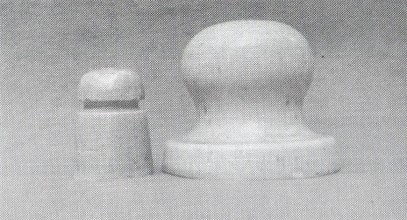
Sim U-4 (left) and U-376 (right) with marking: LIMA, N.Y.
Both insulators have a unique Lima glaze consisting
of light blue and dark blue specs.
| 